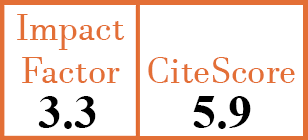Full Papers
Identification of biomarkers associated with pyroptosis and autophagy in facet joint osteoarthritis
X. Zhou1, C. Li2, T. Wang3, Q. Li4, G. Xu5, Z. Cui6
- The First People’s Hospital of Nantong, The Second Affiliated Hospital of Nantong University, Research Institute for Spine and Spinal Cord Disease of Nantong University, Nantong, Jiangsu, China.
- The First People’s Hospital of Nantong, The Second Affiliated Hospital of Nantong University, Research Institute for Spine and Spinal Cord Disease of Nantong University, Nantong, Jiangsu, China.
- The First People’s Hospital of Nantong, The Second Affiliated Hospital of Nantong University, Research Institute for Spine and Spinal Cord Disease of Nantong University, Nantong, Jiangsu, China.
- The First People’s Hospital of Nantong, The Second Affiliated Hospital of Nantong University, Research Institute for Spine and Spinal Cord Disease of Nantong University, Nantong, Jiangsu, China.
- The First People’s Hospital of Nantong, The Second Affiliated Hospital of Nantong University, Research Institute for Spine and Spinal Cord Disease of Nantong University, Nantong, Jiangsu, China.
- The First People’s Hospital of Nantong, The Second Affiliated Hospital of Nantong University, Research Institute for Spine and Spinal Cord Disease of Nantong University, Nantong, Jiangsu, China. czmspine@ntu.edu.cn
CER18579
Full Papers
PMID: 40693421 [PubMed]
Received: 29/01/2025
Accepted : 09/06/2025
In Press: 21/07/2025
Abstract
OBJECTIVES:
Facet joint osteoarthritis (FJOA) is a degenerative spinal joint condition causing low back pain due to cartilage loss and joint damage. Although some studies have highlighted the importance of pyroptosis or autophagy in cartilage loss under FJOA, no report has identified the biomarkers between the two biological events. This direction demonstrates innovative potential and scientific value. The present study aimed to screen differentially expressed genes (DEGs) linked to pyroptosis and autophagy in FJOA and identify potential biomarkers for FJOA.
METHODS:
We collected the lumbar facet joints, performed transcriptome sequencing, used a variety of bioinformatics methods to obtain differentially expressed genes (DEGs), and obtained autophagy-related and pyroplosis-related genes (APRGs) from GeneCards database, and then screened out 17 APRGs. Two machine learning methods were used to identify potential biomarkers. Subsequently, clinical sample experiments and cellular experiments were carried out to validate.
RESULTS:
We found 7,783 DEGs in samples of FJOA patients and obtained 1,153 autophagy-related genes and 80 pyroptosis-related genes from the GeneCards database. 17 APRGs were screened out from the intersection of the three gene sets. Furthermore, CD274, DDX3X, Caspase-8, and MAPK14 were identified as FJOA characteristic biomarkers. We identified that DDX3X, Caspase-8, and MAPK14 were positively correlated with pyroptosis and autophagy in clinical samples and cell experiments, while CD274 was negatively correlated.
CONCLUSIONS:
Our study identified CD274, DDX3X, Caspase-8, and MAPK14 in chondrocyte and articular cartilage of articular process with pyroptosis and autophagy in FJOA. Therefore, the four genes are expected to be promising therapeutic targets for FJOA, our findings may provide novel insight in clinic.


